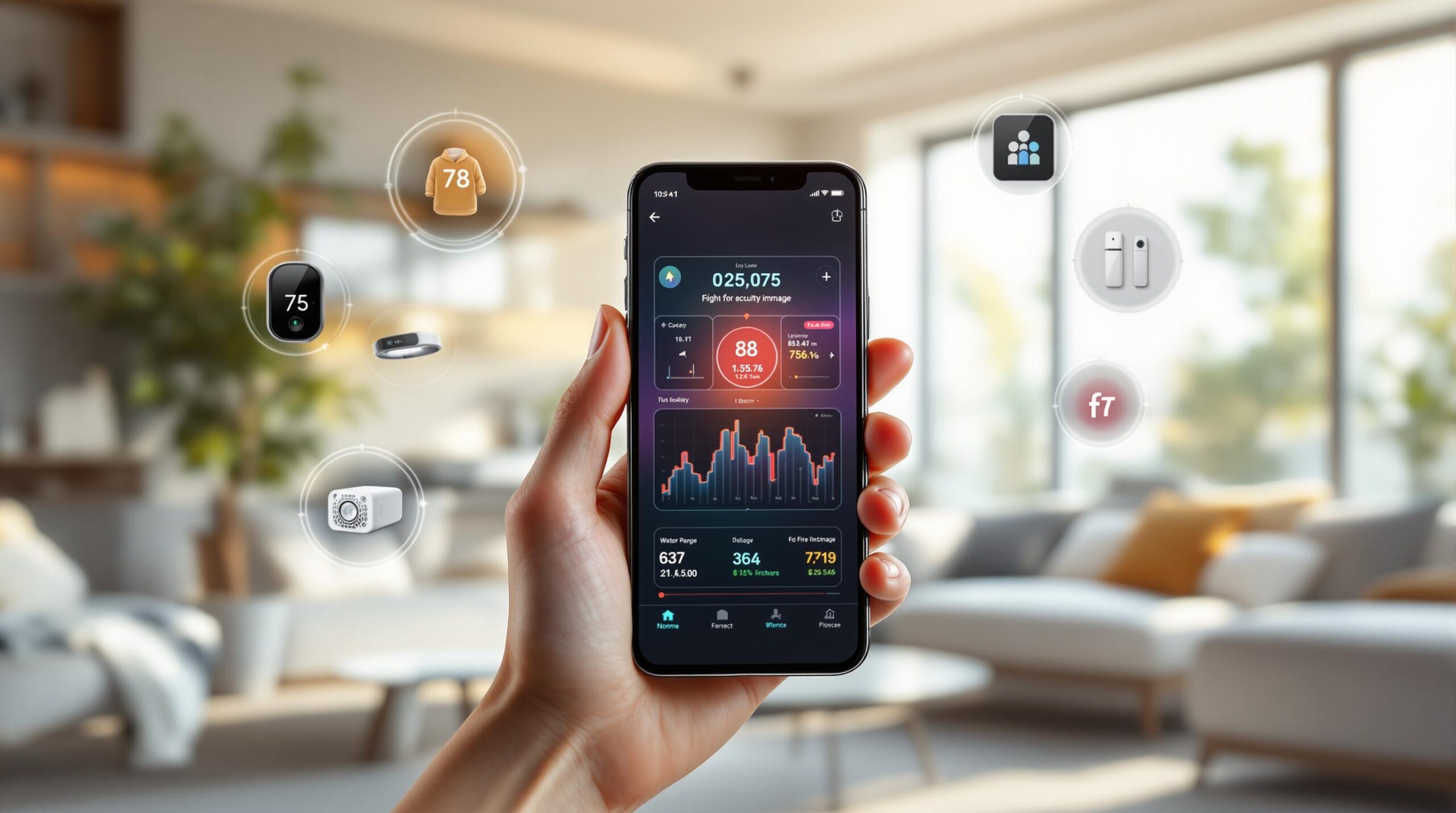
Mobile apps are the central hub for controlling IoT devices in 2025. They connect with billions of devices using technologies like Bluetooth Mesh, 5G, and edge computing to ensure fast, reliable, and secure communication. Here’s a quick breakdown:
-
Key Technologies:
- Bluetooth Mesh: Supports large networks with industrial-grade security and battery efficiency.
- 5G + Edge Computing: Enables ultra-low latency and real-time data processing.
- LPWAN: Powers long-distance, low-energy IoT applications like smart agriculture.
-
Common Challenges:
- Connectivity: Maintaining stable links across Wi-Fi, Bluetooth, and cellular networks.
- Security: Protecting sensitive data with encryption (e.g., AES-256) and multi-factor authentication.
- Scalability: Managing large IoT networks without performance issues.
-
Future Trends:
- AI Integration: AI at the edge makes instant decisions, improving efficiency.
- Unified Standards: Protocols like Matter simplify IoT-mobile integration.
Mobile apps are evolving to handle IoT data better, offering user-friendly interfaces, real-time controls, and enhanced security. These advancements are shaping industries like healthcare, logistics, and smart homes, making IoT systems smarter and more accessible.
Powering AI for Adaptive Mobile and IoT Apps
Key Technologies for IoT-Mobile Communication
By 2025, technologies like Bluetooth Mesh, 5G, and edge computing are transforming mobile-to-IoT communication with faster connections, improved reliability, and smarter data handling.
How Bluetooth Mesh Works
Bluetooth Mesh creates a decentralized network that supports many-to-many communication, capable of handling up to 32,000 nodes. In real-world use, networks frequently manage over 1,000 nodes. As noted by the Bluetooth® Technology Website:
"Bluetooth® Mesh Networking is ideally suited for control, monitoring, and automation systems where hundreds or thousands of devices need to communicate with one another."
Here are some standout features of Bluetooth Mesh:
| Feature | Description |
|---|---|
| Remote Provisioning | Makes adding and setting up devices easier |
| Industrial-Grade Security | Offers 256-bit encryption and identity protection |
| Battery Efficiency | Powers low-energy nodes for years on a single coin-cell battery |
| Native Support | Works seamlessly with modern smartphones and tablets |
The next step in advancing mobile-to-IoT communication is the integration of 5G and edge computing.
5G and Edge Computing Benefits
Pairing 5G with mobile edge computing (MEC) brings data processing closer to where it’s generated, leading to better performance and efficiency. Some of the main benefits include:
- Ultra-low latency for near-instant data processing
- Higher bandwidth to handle large IoT data streams
- Cost savings by reducing network traffic
- Energy efficiency with lower device power usage
LPWAN Technology Applications
Low Power Wide Area Networks (LPWAN), including LoRaWAN and NB-IoT, are ideal for connecting IoT devices across long distances. They are particularly useful for applications like remote monitoring, smart agriculture, and urban infrastructure, thanks to their ability to extend battery life and maintain coverage over vast areas.
Security Methods for IoT-Mobile Systems
IoT devices handle sensitive data more than ever, making secure mobile communications a top priority. In 2023, only 13% of the global population used data protection measures, highlighting the pressing need for better security solutions.
Data Encryption Standards
Modern IoT-mobile systems depend on multiple layers of encryption to protect data during transmission. AES-256 is widely recognized as a leading choice for symmetric encryption, with brute force attacks estimated to take around 10^18 years to crack. Here are some commonly used encryption methods:
| Encryption Type | Best Use Case | Key Advantage |
|---|---|---|
| AES-256 | Real-time data collection | Fast processing speed |
| AES-CTR 256 | Partial file access | Improved access efficiency |
| ECC | Low-power IoT devices | Low resource consumption |
| ML-DSA | Future-ready systems | Resistant to quantum attacks |
These encryption techniques should be paired with strict security protocols for devices.
Device Security Protocols
Protecting IoT devices requires a layered approach that focuses on authentication and access control. Some key practices include:
- Multi-Factor Authentication: Replace outdated SMS-based verification with token-based methods like OAuth2 and JWT for better security.
- Certificate Pinning: Use dynamic certificate pinning to verify server certificates and secure HTTPS communications.
- Runtime Security: Implement tools like App Instance Secure Strings and Runtime Secrets to safeguard sensitive app data.
Mobile security expert Paulo Renato points out:
"Mobile app security is an ongoing process that requires regular updates and improvements."
Additional measures like real-time monitoring, mandatory re-authentication for critical actions, and clear protocols for handling token expiration can further enhance security.
sbb-itb-7af2948
Managing IoT Data in Mobile Apps
In 2025, mobile apps need to handle IoT data efficiently to maintain performance and improve user experience.
Data Processing Methods
Modern IoT systems rely on tiered processing to handle real-time data streams effectively. The sheer volume of daily data requires well-thought-out strategies. A multi-tiered approach is often the best solution:
| Processing Level | Implementation | Purpose |
|---|---|---|
| Edge Processing | Device-level filtering | Reduces the amount of data sent over the network |
| Cloud Processing | Batch analytics | Handles and stores historical data for analysis |
| Real-time Processing | Stream processing | Provides immediate responses from connected devices |
Edge computing is a key part of this strategy. Devices handle initial data processing locally, cutting down the network load and speeding up response times. This setup also lays the groundwork for designing user-friendly interfaces.
IoT Interface Design
Once data flows are optimized, creating clear and responsive interfaces becomes essential. Here are some important principles for interface design:
- Focus on showing controls that are relevant to the user’s current context.
- Incorporate hands-free control options, such as natural language processing.
- Use augmented reality to display device status and controls in a more interactive way.
Machine learning helps refine these interfaces by quickly adjusting to user behavior and preferences. Combining efficient edge processing with well-designed interfaces simplifies IoT management. Platforms like Azure IoT and Google Cloud IoT, along with tools like Node-RED, make prototyping and deployment faster and easier.
Next Steps in IoT-Mobile Technology
Advancements in data handling and security are paving the way for new technologies that strengthen IoT-mobile connectivity.
AI in IoT Systems
By 2025, AI at the network edge will allow mobile apps to make instant, smart decisions, cutting down on bandwidth use and latency.
"The genius of combining artificial intelligence with connected devices is that it fundamentally reshapes what’s possible in networked systems. We’re witnessing a shift from simple data collection to intelligent decision-making right where the information originates. This new architecture doesn’t just save bandwidth; it creates an entirely new class of system that can understand its environment, make real-time decisions, and continuously improve its performance. I believe this fusion of intelligence and connectivity will define the next era of technology – opening doors to applications we haven’t even imagined yet."
AI-powered IoT applications are making waves in various fields:
| Application Area | AI Enhancement | Impact |
|---|---|---|
| Health Monitoring | Real-time analysis of signals | IoT healthcare market to grow at 17.8% CAGR, reaching $289B by 2028 |
| Fitness Tracking | Personalized recommendations | Creates virtual fitness coaches with tailored advice |
| Environmental Sensing | Automated data categorization | Improves accuracy and organization of environmental data |
| Device Management | Predictive maintenance | Cuts downtime and lowers maintenance expenses |
Mi Zhang explains, "AIoT transforms simple data collection into smart, personalized interactions, evolving a basic step-tracker into a virtual fitness coach that offers tailored recommendations while safeguarding user privacy."
IoT Communication Standards
Unified standards like Matter are streamlining IoT-mobile integration. Matter 1.3 introduces improved features for water and energy management, major appliances, TV controls, and enhanced user experiences with scene support and command batching.
The Connectivity Standards Alliance (CSA) has already certified nearly 200 Matter devices. Additionally, Zigbee Direct enables Bluetooth-enabled devices to interact directly with Zigbee networks, with contributions from over 50 CSA member companies.
The AIoT market is on a rapid growth trajectory, expected to jump from $18.37 billion in 2024 to $79.13 billion by 2030, with a CAGR of 27.6%. This highlights the growing role of standardized communication protocols in mobile app development.
Conclusion: IoT-Mobile Development Guide
Key Technology Overview
By 2025, mobile-to-IoT communication will depend on technologies that improve connectivity and performance. Bluetooth Mesh supports large-scale device networks, while 5G and edge computing enable fast, localized processing for real-time responsiveness. Meanwhile, AI-powered systems streamline data management with advanced analytics and automation.
| Technology | Primary Use Case | Implementation Impact |
|---|---|---|
| Bluetooth Mesh | Device Networks | Enables large-scale mesh networking |
| Edge Computing | Local Processing | Reduces latency with localized processing |
| AI-Powered Systems | Smart Analytics | Improves real-time decision making |
These technologies form the backbone of efficient and secure IoT-mobile integration. However, their implementation demands skilled execution.
Collaborating with Development Teams
To bring these technologies to life, working with experienced development teams is essential. These teams ensure mobile apps are designed for optimal performance and compatibility within IoT systems.
For healthcare and research, focus on these priorities:
- Data Security: Use encryption and enforce strong device authentication.
- Performance: Leverage edge computing to ensure real-time processing.
- Compliance: Adhere to data protection laws and industry standards.
- User Experience: Design intuitive interfaces for IoT networks.
As AI-powered IoT solutions continue to advance, teaming up with experts in mobile and IoT development ensures your applications can scale effectively while maintaining high security and performance. This strategy lays the groundwork for successful IoT-mobile integration, particularly in healthcare and research environments.

